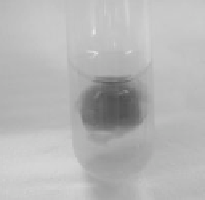Environmental Engineering Reference
In-Depth Information
FIGURE 2.23
Photograph of a PNIPAM hydrogel immersed in a dilute solution of a dye (black eriochrome T). Note the higher
coloration of the gel compared with the surrounding solution due to the preferential partition of the dye into
the gel.
(black eriochrome T) is preferentially absorbed from aqueous solution. The property can
be used to remove contaminant dyes from wastewater.
2.4.5 Adsorbing Nanoparticles Fixed Inside Hydrogels
Metal oxides easily adsorb arsenic anions [164]. Accordingly, magnetic nanoparticles
have been extensively used to adsorb arsenic from contaminated drinking water [165].
The nanoparticles with arsenic ions adsorbed in the surface can be separated by magnetic
means. However, the risk of nanoparticle leakage into the drinking water exists. It is pos-
sible to synthesize magnetite (Fe
3
O
4
) nanoparticles (MagNP) by a well-known chemical
method [166]. These nanoparticles could be used to detect and/or remove arsenite ions
from water. We have loaded magnetite (Fe
3
O
4
) nanoparticles into macroporous hydrogels
(Figure 2.11). The whole hydrogel can be manipulated by a magnet, and arsenic ions can be
adsorbed from the solution without the risk of nanoparticle leakage.
2.4.6 Toxic Metal Ion Absorption into Hydrogels Functionalized
with Hydrophobically Retained Chelating Agents
Metal ions can be highly toxic to aquatic life [167]. While surface adsorption on porous
solids is a highly effective process for metal ion removal from water, the amount removed
per unit weight is relatively low [168]. Liquid/liquid extraction into water-immiscible
organic solvents is more effective because of the use of bulk absorption instead of sur-
face adsorption; however, it is prone to contaminate the water with the organic solvent
[169]. Hydrophobic organic chelating agents could be used to complex with the hydrophilic
ions and promote their transfer to the hydrophobic organic solvent [170]. Fixing chelating
groups inside the polymer matrix will produce the same effect. One way to incorporate
the chelating groups in polymers is copolymerization [171]; however, it requires com-
plex synthesis of new polymers. On the basis of the hydrophobic properties of polymeric
hydrogels, we thought that organic chelating agents should be able to speciically complex
metal ions and promote their absorption into solid hydrogels. Figure 2.24 shows PNIPAM
hydrogel loaded with phenanthroline (phen) and then immersed in an iron(II)-containing
solution. As it can be seen, the gel is colored by the formation of the
Fe phe( )
2+
complex
inside the gel. The metal ion could be released into a waste solution by protonation of the
phenanthroline chelate at a pH well below its pKa (pKa = 4.8 [172]).
However, numerical evaluation of the partition coeficient (Table 2.4) indicates that
the hydrogel retains less of the complex than the free chelating agent. It seems that the

